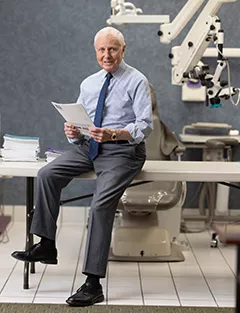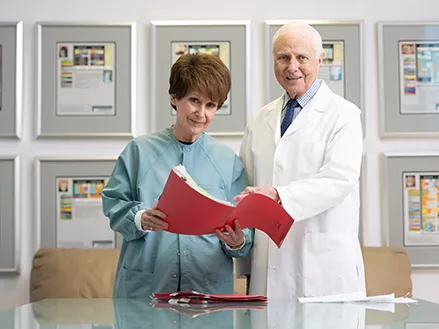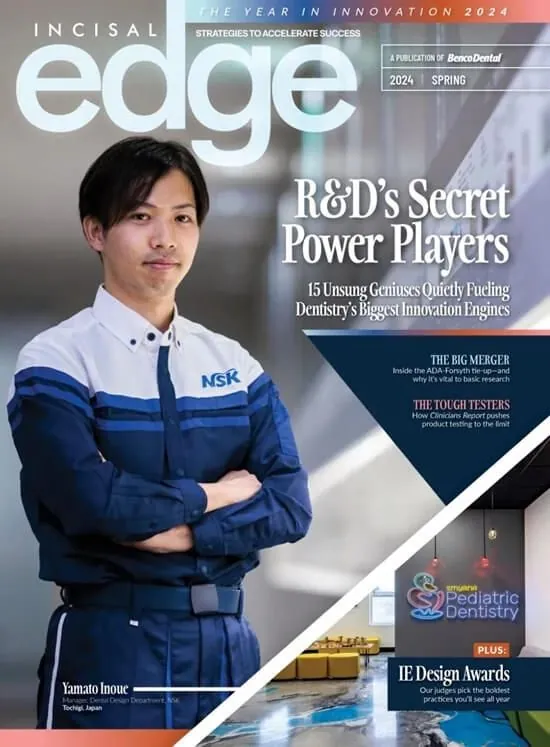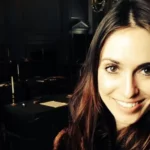Lion in winter? Hardly. Dr. Gordon J. Christensen is as close to a Mt. Rushmore figure as modern dentistry has produced, but he’s not remotely ready for the sculptor’s chisel just yet. This figure of colossal influence invented modern dental product reviews; he has taught thousands of hours of CE courses around the world; and he and his partner in work and life, Dr. Rella Christensen, have done more than any two people to transform the science and practice of dentistry. And although he’s thinking about the future of the business he has built, he’s not going anywhere soon. “I have no health problems whatsoever,” he says. “Although I’m 85, I feel like I did 40 years ago.”

The 85-year-old cofounder (with his wife, Dr. Rella Christensen) of the Gordon J. Christensen Clinicians Report is still a workaholic. Since he and Rella founded Clinical Research Associates Foundation, a nonprofit product evaluation organization now known as the CR Foundation, in 1976, Clinicians Report—published monthly—is read by an estimated 100,000 dentists in 92 countries. (Rella was the director of CRA for 27 years; Gordon has been CEO until now.)
We were told we would fail by many colleagues. Forty-six years later, we’re still going.”
Through his international continuing-education organization, Practical Clinical Courses (PCC), Dr. Christensen has taught over 45,000 hours of CE classes. He travels the globe to speak some 70 to 100 times a year, interacting with between 40,000 and 60,000 dental professionals worldwide, he estimates. PCC continues to launch videos and virtual and in-person learning sessions covering topics as diverse as handling an embezzling employee and avoiding an implant failure.
“I start my working day at about 5:30 a.m. He is often well into it by that time,” says Dr. Rory Hume, dean of the University of Utah School of Dentistry, who has known Dr. Christensen for more than 50 years. “I am in awe of his energy and his commitment, which just continue unabated. We all know that we are mortal, but he continues as if he is not.”
He is, in sum, a figure whose industry transcendence is akin to that of, say, Muhammad Ali. However—and this is an important distinction—unlike Ali or others of his ilk, Dr. Christensen has no enemies, no one sniping about his character, no one moaning that he has not earned his legendary status. A fixture on the 32 Most Influential list since its inception—he’s one of a handful of who have made a full six appearances—slots in at No. 12 this year. His place in our pages, however, is hardly the most illustrious accolade he has earned over his long career. In 2015, the late Utah Senator Orrin Hatch (to whom Dr. Christensen, coincidentally, bears a resemblance) gave a speech in front of President Obama in which he put a fine point on his unequaled contributions to the cause of better oral health.
“A renowned educator and highly regarded prosthodontist,” Hatch called him, adding that “after more than 55 [now 62] years in private practice, he continues to influence dentistry across the world through his continuing education lectures and the Clinicians Report. He is truly one of dentistry’s great leaders.”
The late senator was hardly alone in his esteem. “He can be labeled the godfather of modern dentistry,” says Dr. Michael Dorociak, chairman of the board for the CR Foundation and a clinical evaluator for Clinicians Report. “At a time when the profession has changed dramatically, he has been one of the mainstays.”
What makes him tick, though? What, at his age, can he possibly be pursuing? What laurel is left to earn? Part of it is his abiding religious faith. “It is the overriding reason that I live,” Dr. Christensen says. “I think we are all here for a purpose. We just have to find it.”
“It’s a spiritually led mission for [Gordon and Rella],” Dr. Dorociak says. “A belief and a principle that they can do this to help their common man. A lot of their research is to help the patient, not the dentist.”
. . .
WHILE HE’S GOING nowhere in the immediate future, after 46 years at the CR Foundation sharing responsibilities with his wife, he and Rella have decided it’s time to appoint a co-CEO who will work with them in all aspects of the foundation.
The search for this new co-CEO has taken time. “I have been looking for a broad-based practitioner scientist for a decade,” Dr. Christensen says from his wood-paneled office in Provo, just north of Mapleton. “Rory Hume called and said he’d like to establish an endowed chair [at the University of Utah School of Dentistry] in my name and my wife’s name. It would unite the academic and the real world—or the town and the gown, as I say.”
The chair will serve as a link between the university and Clinicians Report: an academic-clinician who will work with the CR Foundation but also serve at the university to offer students, professors and other academics a chance to participate in foundation research.
Dr. Christensen agreed to Dr. Hume’s proposal, and the university conducted an international search, interviewing a half-dozen candidates for the role. In September 2020, the university’s board of trustees named Dr. Mark Durham—a prosthodontist, practicing dental specialist and professor who spent more than a decade practicing part-time at the Veterans Affairs Medical Center in Salt Lake City and teaching at the University of Utah School of Dentistry—as the inaugural holder of the Gordon and Rella Christensen Presidential Endowed Chair, a seat he will initially hold for five years. Dr. Durham, 45, is “an extremely bright person,” Dr. Christensen says, “into AI, virtual learning and other areas most people aren’t even thinking about yet.”
I’m in awe of Gordon’s energy and commitment. We all know we’re mortal, but he continues as if he’s not.” —Dr. Rory Hume, dean of the University of Utah School of Dentistry
Says Dr. Hume, “Gordon liked him because he said he’s ‘eclectic.’ Dr. Durham is a specialist prosthodontist, like Gordon. He’s a creative and energetic individual who is also very entrepreneurial and interested in educational technologies, which is turning out to be of value to the foundation.”
Dr. Durham has been working with the CR Foundation for a year and a half since his appointment and has developed a new way to evaluate products that brings together faculty and practitioners throughout the area, Dr. Hume says. Roughly once a month, Dr. Durham assembles 20 to 30 senior students, residents, faculty members and practicing professionals from around the Salt Lake City area in the university’s simulation labs to test new materials and devices, and relay that research back to CR.
Dr. Durham’s transition to co-CEO of the CR Foundation will be official by the time you read this, when he’ll take the reins of its research division. Dr. Christensen will continue to lead the educational division. “I am not leaving,” he is quick to note. “I have no health problems whatsoever.Although I am 85, I feel like I did 40 years ago. My family all lived into their nineties.”
. . .
GORDON JOHNSON CHRISTENSEN was born November 10, 1936, and spent the first six years of his life in a small, rural house in Lewiston, Utah, in the northeast part of the state near the Idaho border. The family home had only a coal stove and an outdoor toilet.
His father was a carpenter and later an administrator at a local beet-sugar refining factory. He had one sibling, older brother Boyd, a Stanford MBA who served in Europe during World War II and who, in the late ’60s and early ’70s, was president and then vice-chairman of Allstate Insurance Companies, managing 23,000 employees.
When Gordon was 17, he enrolled in predental studies at Utah State University and went on to attend the University of Southern California School of Dentistry, where he served as student body president and met Rella Parisi. (“I expected to be a typical general dentist in Santa Barbara, California,” he says, calling to mind the old line about best-laid plans.) He then attended the University of Washington, earning a degree in restorative dentistry and prosthodontics in 1963 and kicking off his career with a teaching position there.
His knack for classroom instruction got him recruited to help start the dental school at the University of Kentucky in 1965. A few years later, he was lured away to do the same at the University of Colorado. During his stint there, he earned his Ph.D. in higher education and psychology from the University of Denver in 1972. He became a full-time professor at age 28. (He would later serve as dean of the Scottsdale Center for Dentistry in Arizona from January 2007 to November 2009.)
Over his time in academia, Dr. Christensen was appointed to several national and international research committees that evaluated products intended for use by dentists. The committees would ultimately provide recommendations to governing bodies and regulators about whether to approve the products for mass use.
“I was somewhat frustrated with some of the committees,” Dr. Christensen says. Powerful, wealthy groups often spent money to try to influence approvals, and much of the committees’ work was a function of which products could even make it as far as the approval stage. “I asked my wife, later to become a Ph.D. in physiology and microbiology, to help form a nonprofit foundation that did not have money as a major goal.”
In 1976, the Christensens founded Clinical Research Associates. The idea was to enlist dentists, hygienists, assistants and laboratory technicians around the world who would use products, evaluate them and follow their service over time using clinical and scientific methodologies. The foundation was to have a basic science team to validate the clinicians’ reports, and the results would then be published in Clinicians Report.
The Christensens caused manufacturers to change, caused dentists to treat their patients better, made dentists more productive. They have always set out to do the right thing for dentists and patients.” —Dr. Michael Dorociak, chairman of the board, CR Foundation
The first product testers came from the 120 or so dentists who participated in the study groups Dr. Christensen convened and ran in several states. CR now counts around 450 clinicians in nearly 20 countries who test up to 700 new products a year, performing over 20,000 field evaluations annually. Additionally, the CR Foundation and Practical Clinical Courses employ roughly 40 scientists, educators and support staff at their Provo headquarters.
Dr. Christensen compares the CR Foundation’s work to that of Consumer Reports. The foundation was established on the principle that evaluators and results needed to be objective and impartial. The evaluators donate their time and expertise, as do both Christensens. The products they assess, which include materials, devices, equipment, technologies and techniques, are obtained from companies or sent to CR by clinicians, patients or inventors. CR does not charge the companies for its evaluations or accept money from them. Any product valued at $100 or more is returned to the respective company after the evaluation.
The CR Foundation and its testing operations are financed primarily through subscriptions to Clinicians Report, which in the United States run $29 a month or $299 a year. Other funding comes from Dr. Christensen’s and his staff’s speaking gigs, plus donations, the latter making up about 20 percent of the foundation’s revenue. “We were told we would fail by many of my colleagues,” he says, a hint of satisfaction creeping into his voice. “Forty-six years later, we’re still going.”
. . .
“EVERY DENTAL PATIENT in the world, certainly every dentist, has benefited from this place,” says Dr. David Wright, a Clinicians Report project director, speaking to Incisal Edge from his practice in Michigan. In the 30 years he has been an evaluator for the publication, he says one product truly stood out. In the early 2000s, when CAD/CAM technology was relatively new in dentistry, firms developed and marketed materials and concepts for, among other things, dental crowns and bridges. “Many companies were claiming all sorts of things, and Drs. Rella and Gordon took the CAD/CAM concept on with in-the-mouth trials of all these materials and CAD/CAM technology—fortunately, before many general dentists began using them.”

PARTNERS: Drs. Rella and Gordon Christensen, who met at the University of Southern California School of Dentistry in the late 1950s
Additionally, Rella led a research project on the then-new type of dental crown: zirconia. She directed dentists to make impressions, which she and her team double-checked to be sure they were “ideal,” as Dr. Wright puts it. The impressions were then sent to the companies themselves, and on to some of the best lab technicians in the industry. Some products worked, but many did not, including one brand of dental fixed bridge that broke in every case in under a year, Dr. Wright says. “The fact that we did our research ahead of time saved hundreds and hundreds of failures.” Dr. Dorociak, a practicing dentist in Florida and CR’s chairman of the board, says the foundation has made notable recent contributions as well. During the pandemic, the Christensens launched two projects to test products being presented as possible tools to help dentists treat patients safely.
One example tested in CR’s nonprofit TRAC [Technologies in Restoratives and Caries] division was whether Covid-19 viruses and other microbes could be removed by filters in a negative-air-pressure room. “Dr. Rella and her team supervised building and operating a negative-air-pressure operatory—spent $30,000 to enclose a room completely—and placed microbes in the room,” Dr. Dorociak says. “The study found that it did not remove all the microbes and would not be a solution in dentistry. A similar study of many so-called air purifiers was negative and saved practitioners thousands of dollars.”
Another project tested dental aerosols that purportedly sanitized surfaces, a key concern early in the pandemic. Dr. Dorociak says the research helped expose disinfectants that failed to sanitize biological matter often found in dental offices. If the disinfectants could not break through the so-called “bioburden,” they would not be able to kill SARS-CoV-2, he notes.
The Christensens have made a colossal impact on “the whole dental profession” over their decades of service, Dr. Dorociak says. “They have caused manufacturers to change, caused dentists to treat their patients better, made dentists more productive,” he says. The two Drs. Christensen, jointly as humble as they are world-changing, “have always set out to do the right thing for dentists and dental patients.”




